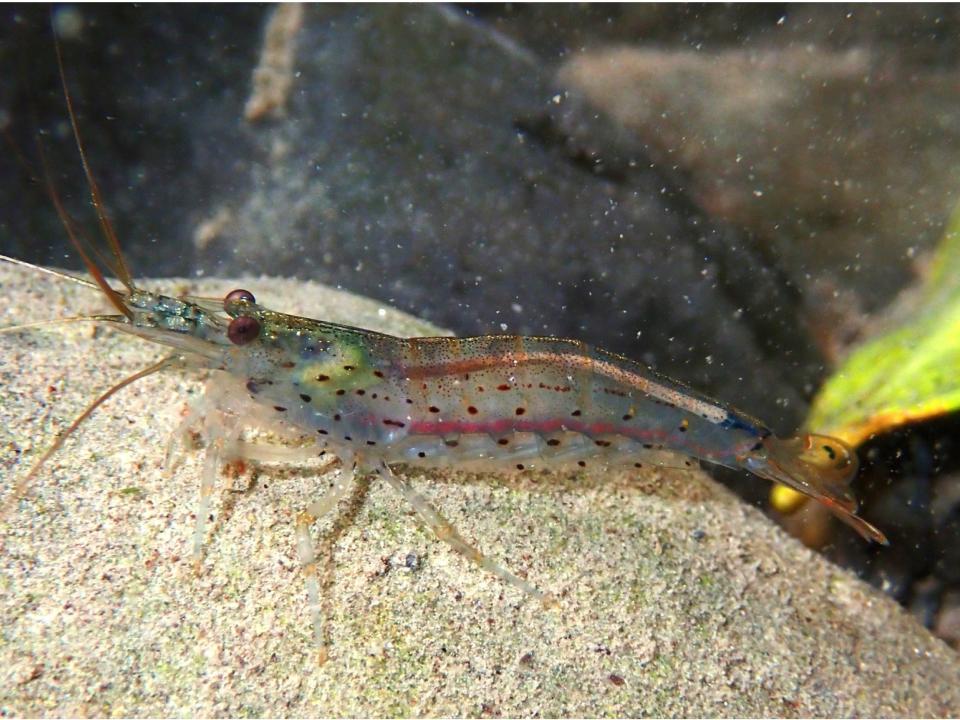Ravaux, J., Bosc, O., Boinet, C., Fusari, C.-E., Lamoureux, J., Trancart, T., & de Mazancourt, V. (2025). Habitat selection and copper toxicity in the freshwater amphidromous shrimp Caridina multidentata Stimpson, 1860 (Decapoda: Caridea: Atyidae). Journal of Crustacean Biology, 45(2), 20. https://doi.org/10.1093/JCBIOL/RUAF020
Amphidromous atyid shrimps, like Caridina multidentata Stimpson, 1860, play a crucial role in freshwater ecosystems. Despite their ecological significance, our understanding of the factors influencing their distribution, abundance, and behaviour remains limited. We aim to fill this knowledge gap by investigating the sensory ecology of C. multidentata, focusing on the role of biotic and abiotic factors in microhabitat selection and response to environmental stressors such as pollution. Olfactory choice tests indicated that the shrimp did not respond to chemical cues from conspecifics or heterospecific species, but displayed a preference for environments with current flow and avoided light. They did not demonstrate a preference for a “refuge” combination of conditions, suggesting that they did not perceive a threat in the experimental setting and were able to distribute themselves according to their preferred conditions of darkness or current. Acute toxicity tests established a median lethal concentration (LC50) of copper at 1.15 mg l–1. Pre-exposure to sublethal copper concentrations impaired the ability of shrimp to detect food odours, suggesting potential impacts on habitat selection and survival. Future research should investigate the long-term effects of pollutants on the behaviour and survival of shrimp, and explore the role of environmental cues such as river chemical waterscape.
BOREA contact: Juliette Ravaux, juliette.ravaux@sorbonne-universite.fr
Légende/Picture title :
Fig.1. The system for choice experiments with Caridina multidentata consisted of two circular PVC compartments (35 cm in diameter, 20 cm high) linked by a connection tunnel (5 cm long, 5 cm wide, 20 cm high) (A, B). A feed tank equipped with a pump was connected to each of the circular compartments through a water inlet chamber, allowing for the continuous injection of water throughout the experiment at rate of 4 l min–1. The use of PVC plates next to the connection tunnel was intended to prevent the mixing of water in the tunnel and facilitate the establishment of a circular flow in the compartments. A water outlet chamber evacuated water to the feeder tank via an overflow system. The injected water rotated within each compartment, preventing any mixing between the two. A preliminary test was conducted to validate the system by injecting a blue dye solution into one of the tanks, and it was observed that there was no mixing with the other tank (C). An additional light source was added to the left-hand test compartment in a set-up for light tests (D). © Ravaux et al.
Fig. 2. Responses of Caridina multidentata to chemical stimuli in choice experiments expressed as percentage of time spent in each compartment; significant differences indicated with an asterisk (A–D). Food stimulus (artificial pellets) (A), conspecific stimulus (individuals of C. multidentata) (B), European eel Anguilla anguilla stimulus (mucus) (C) cichlid Amphilophus sp. stimulus (mucus) (D). The individual tested spent 5–10% of the time in the connecting zone between two test compartments (neutral zone, not shown). Responses expressed as time to reach the compartment containing the stimulus, values with different letters are significantly different (E). Each experiment was conducted on a sample size of ten individuals. Data are represented as box plots, with whiskers indicating the minimum and maximum, the box delimiting the first quartile and third quartile, the median identified by a continuous horizontal line and the mean identified by a dotted line (the value for the mean is shown next to the line). Extreme points are represented as circles. © Ravaux et al.
Fig. 3. Responses to abiotic stimuli in Caridina multidentata individuals expressed as percentage of time spent in each compartment; significant differences are indicated with an asterisk (A–E). No flow (0 l min–1) versus control flow (4 l min–1) (A), control flow (4 l min–1) versus high flow (6 l min–1) (B), no light versus ambient light (50 lux) (C), ambient light (50 lux) versus high light (750 lux) (D) no flow and no light versus control flow (4 l min–1) and ambient light (50 lux) (E). The individuals tested spent 4 –11% of the time in the connecting zone between the two test compartments (neutral zone, not shown). Responses expressed as time to reach the compartment containing the stimulus, values with different letters are significantly different (F). Each experiment was conducted on a sample size of ten individuals. Data are represented as box plots, with whiskers indicating the minimum and maximum, the box delimiting the first quartile and third quartile, the median identified by a continuous horizontal line and the mean identified by a dotted line (the value for the mean is shown next to the line). Extreme points are represented as circles. © Ravaux et al.
Fig. 5. Responses of individuals of Caridina multidentata to food stimulus after pre-exposure to a pollutant (CuSO4) in choice experiments expressed as percentage of time spent in the control compartment and in the compartment with the food stimulus after pre-exposure to copper (CuSO4 + food) (A). The mean time spent by individuals in the connecting zone between the two test compartments was 13% (neutral zone, not shown). Responses expressed as time to reach the compartment containing the food for non-tested (food) and copper-tested (CuSO4 + food) shrimp (B). Data are represented as box plots, with whiskers indicating the minimum and maximum, the box delimiting the first quartile and third quartile, the median identified by a continuous horizontal line and the mean identified by a dotted line (the value for the mean is shown next to the line). Significant differences are indicated with an asterisk. © Ravaux et al.









